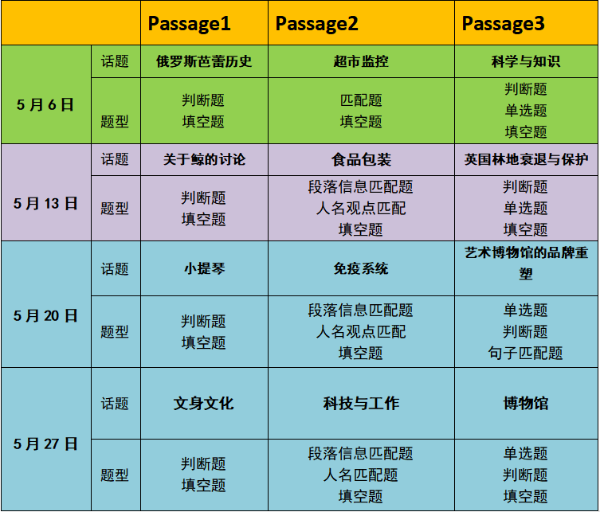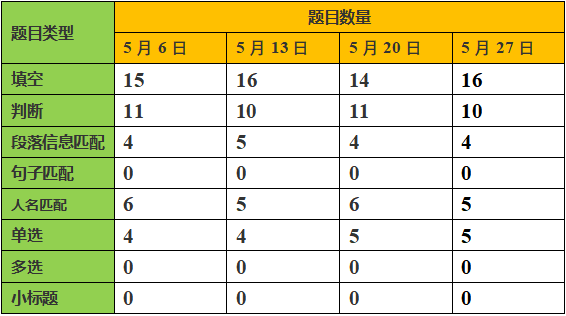2023年5月一共4场雅思纸笔考试,四场考试难度有一定的差异。接下来新航道重庆学校雅思阅读老师为大家整理了相关解析,5月所有纸笔考试中阅读文章话题和题型并给出了备考建议。
1. 雅思阅读文章话题和题型

2. 雅思阅读各题型占比

5月6日阅读三篇均是老题,题型和文章难度也都是中规中矩,在5月份的考试中,算是比较简单的一次考试。
5月13日虽然三篇文章也都是老题,但是相对来说还是比较新的,都是2020年之后才出的题,所以相关的信息也还比较少。
5月20日的文章是两旧带一新,除了第二篇关于免疫系统的文章是新出的,其他两篇文章均是老题,值得注意的是,第一篇文章有p1,p2两个版本,这也是为什么有时候一套题不一定是按p1
5月27日的阅读毫无疑问是5月的难题担当,虽然题型仍然比较中规中矩,但是文章的难度一下提升了很多。不难发现今年到目前为止已经多次考到博物馆话题了喔,而且难度都不小,因此建议大家可以用剑雅943做参考熟悉博物馆类文章。
3. 真题信息
Tattoo on Tikopia
A
:There are still debates about the origins of Polynesian culture, but one thing we can ensure is that Polynesia is not a single tribe but a complex one. Polynesians which include Marquesans, Samoans, Niueans, Tongans, Cook Islanders, Hawaiians, Tahitians, and Maori, are genetically linked to indigenous peoples of parts of Southeast Asia. It's a sub-region of Oceania, comprising of a large grouping of over 1,000 islands scattered over the central and southern Pacific Ocean, within a triangle that has New Zealand, Hawaii and Easter Island as its corners.
B
Polynesian history has fascinated the western world since Pacific cultures were first contacted by European explorers in the late 18th century. The small island of Tikopia, for many people-even for many Solomon Islanders-is so far away that it seems like a mythical land; a place like Narnia, that magical land in C.S.Lewis'classic, The Chronicles of Narnia. 'Maybe because of it -Tikopia, its people, and their cultures have long fascinated scholars, travelers ,and casual observers. Like the pioneers Peter Dillion, Dumont D'Urville and John Coleridge Patterson who visit and write about the island in the 1800s, Raymond Firth is one of those people captured by the alluring attraction of Tikopia. As a result, he had made a number of trips to the island since the 1920s and recorded his experiences, observations, and reflections on Tikopia, its people, cultures and the changes that have occurred. While engaged in the study of the kinship and religious life of the people of Tikopia, Firth made a few observations on their tattooing. Brief though these notes are they maybe worth putting on record as an indication of the sociological setting of the practice in this primitive Polynesian community. The origin of the English word 'tattoo' actually comes from the Tikopia word 'tatau'. The word for tattoo marks, in general, is tau, and the operation of tattooing is known as ta tau, ta being the generic term for the act of striking.
D
The technique of tattooing was similar throughout Polynesia. Traditional tattoo artists create their indelible tattoos using pigment made from the candlenut or kukui nut. First, they burn the nut inside a bowl made of half a coconut shell. They then scrape out the soot and use a pestle to mix it with liquid. Bluing is sometimes added to counteract the reddish hue of the carbon-based pigment. It also makes the outline of the inscribed designs bolder on the dark skin of tattooing subjects.
E
For the instruments used when tattooing, specialists used a range of chisels made from albatross wing bone which were hafted onto a handle which was made from the heartwood of the bush and struck with a mallet. The tattooer began by sketching with charcoal a design on the supine subject, whose skin at that location was stretched taut by one or more apprentices. The tattooer then dipped the appropriate points-eight era single one or a whole comb-into the ink (usually contained in a coconut-shell cup)and tapped it into the subject's skin, holding the blade handle in one hand and tapping it with the other. The blood that usually trickled from the punctures was wiped away either by the tattooer or his apprentice, the latter having also inevitably painful-a test of fortitude that tattooers sought to shorten by working as fast as possible. In fact, tattoos nearly always festered and often led to sickness-and in some cases death.
F
In ancient Polynesian society, nearly everyone was tattooed. It was an integral part of ancient culture and was much more than a body ornament. Tattooing indicated ones' genealogy and/or rank in society. It was a sign of wealth, of strength and of the ability to endure pain. Those who went without them were seen as persons of lower social status.
As such, chiefs and warriors generally had the most elaborate tattoos. Tattooing was generally begun at adolescence, and would often not be completed for a number ofyears. Receiving tattoos constituted an important milestone between childhood and adulthood, and was accompanied by many rites and rituals. Apart from signaling status and rank, another reason for the practice in traditional times was to make a person more attractive to the opposite sex.
G
The male facial tattoo is generally divided into eight sections of the face. The center of the forehead designated a person's general rank. The area around the brows designated his position. The area around the eyes and the nose designated his hapu, or sub-tribe rank. The area around the temples served to details his signature. This signature was once memorized by tribal chiefs who used it when buying property, signing deeds, and officiating orders. The cheek area designated the nature of the person's work. The chin area showed the person's mana. Lastly, the jaw area designated a person's birth status.
H
A person's ancestry is indicated on each side of the face. The left side is generally the father's side, and the right side was the mother's. The manutahi design is worked on the men's back. It consists of two vertical lines drawn down the spine, with short vertical lines between them. When a man had the manutahi on his back, he took pride in himself. At gatherings of the people he could stand forth in their midst and display his tattoo designs with songs. And rows of triangles design on the men's chest indicate his bravery. Tattoo was a way delivering information of its owner. It's also a traditional method to fetch spiritual power, protection and strength. The Polynesians use this as a sign of character, position and levels in a hierarchy. Polynesian peoples believe that a person's mana, their spiritual power or life force, is displayed through their tattoo.